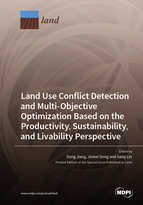Land Use Conflict Detection and Multi-Objective Optimization Based on the Productivity, Sustainability, and Livability Perspective
A special issue of Land (ISSN 2073-445X).
Deadline for manuscript submissions: closed (15 April 2022) | Viewed by 29354
Special Issue Editors
Interests: overall optimization for the Production–living–ecological (PLE) space; remote sensing applications for resources and environment; spatio-temporal simulation for the potential and benefit of renewable energy resources
Special Issues, Collections and Topics in MDPI journals
Interests: remote sensing of global change; land cover and land use change; integrated monitoring and assessment of terrestrial ecosystem
Special Issues, Collections and Topics in MDPI journals
Interests: land use classification and evolvement based on the Production–living–ecological (PLE) Perspective; resource utilization and its environmental impact; water-energy nexus
Special Issues, Collections and Topics in MDPI journals
Special Issue Information
Dear Colleague,
Land use affects regional sustainable development in many aspects, so insight into its influence is of great importance for the optimisation of national space. With the rapid economic growth and the accelerating industrialization, there has been a noticeable increase in the contention and conflict between various land uses. For example, the expansion of urban and industrial land has occupied a large amount of high-quality farmland, leading to serious contradictions between socioeconomic development and cultivated land resources protection. Solving these problems has thus become an important scientific proposition for regional sustainable development in the field of human-economic geography. Based on the widely recognized development goals for productivity, sustainability, and livability perspectives, a scientific classification system, spatial conflict detection and multi-objective optimization of land use functions (LUFs) have provided an efficient means for land use planning and management, sparking extensive attention of researchers and policymakers. For example, Production-living-ecological space (PLE), the shortened form for productive space (PS), living space (LS), and ecological space (ES), is reclassified considering both land use functions and utilization types based on the productivity, sustainability, and livability perspective. First proposed by the Chinese Government Report in 2012, it has made prominent contributions to improving the protection system of spatial development while implementing major function-oriented zoning at all scales. Successful implementation in China proves that PLE contains promotional value to provide support for space use allocation, land use conflict management, and sustainable development. However, compared to the literature available in functional classification and identification based on the productivity, sustainability, and livability perspectives, it is surprising that very few among the increasing number of papers dealing with LUFs are devoted to its conflict detection and multi-objective optimization with land-use planning, which has left many significant questions unanswered. There were few reports on integrated research that especially lack international practical application. Thus, the theoretical research and practical applications of multi-functional complex of land use still need to be further refined.
This Special Issue entitled “Land Use Conflict Detection and Multi-Objective Optimization Based on Productivity, Sustainability, and Livability Perspectives” mainly focuses on the functional classification, spatial conflict detection, and spatial development pattern optimization based on the productivity, sustainability, and livability perspectives, presenting a relevant opportunity for all scholars to share their knowledge from the multidisciplinary community across the world, including landscape ecologists, social scientists, and geographers. Further progress in theoretical research and practical applications on the scientific classification system towards productivity, sustainability, and livability, such as PLE classification of China, are welcome. We also seek integrative studies regarding suitability evaluation, optimized mode of the multi-functional land-use systems, to meet the target of geographical space optimization and regional sustainable development.
Prof. Dr. Dong Jiang
Prof. Dr. Jinwei Dong
Dr. Gang Lin
Guest Editors
Manuscript Submission Information
Manuscripts should be submitted online at www.mdpi.com by registering and logging in to this website. Once you are registered, click here to go to the submission form. Manuscripts can be submitted until the deadline. All submissions that pass pre-check are peer-reviewed. Accepted papers will be published continuously in the journal (as soon as accepted) and will be listed together on the special issue website. Research articles, review articles as well as short communications are invited. For planned papers, a title and short abstract (about 100 words) can be sent to the Editorial Office for announcement on this website.
Submitted manuscripts should not have been published previously, nor be under consideration for publication elsewhere (except conference proceedings papers). All manuscripts are thoroughly refereed through a single-blind peer-review process. A guide for authors and other relevant information for submission of manuscripts is available on the Instructions for Authors page. Land is an international peer-reviewed open access monthly journal published by MDPI.
Please visit the Instructions for Authors page before submitting a manuscript. The Article Processing Charge (APC) for publication in this open access journal is 2600 CHF (Swiss Francs). Submitted papers should be well formatted and use good English. Authors may use MDPI's English editing service prior to publication or during author revisions.
Keywords
- production-living-ecological spaces (PLE)
- spatial conflict classification
- multi-functional dynamic evolution
- multi-objective optimization
- machine learning methods
- land use model








